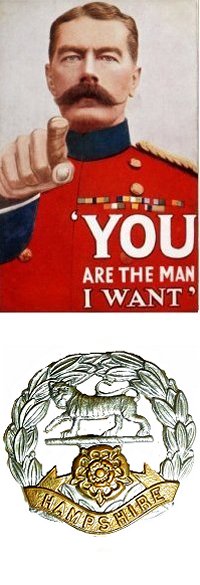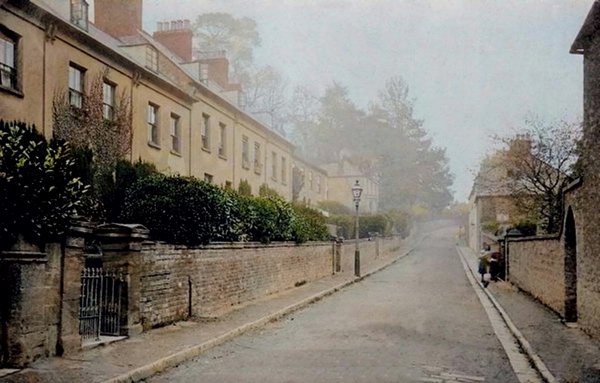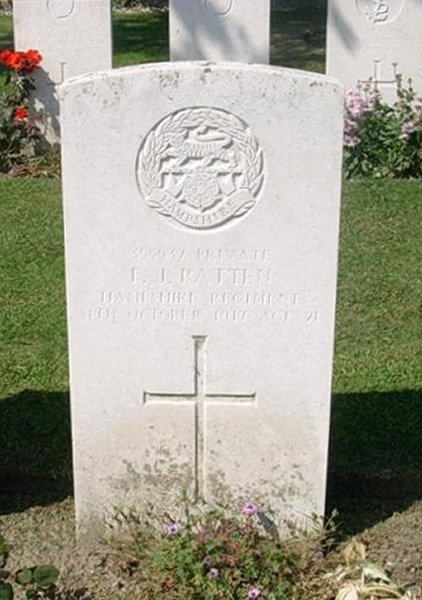yeovil at War
Frederick John Patten
Killed in the Battle of Broodseinde, aged 19
Frederick John Patten was born on 18 January 1898 in Hendford, Yeovil, the son of railway platelayer Maurice John Patten (1869-1948), known as John and originally from Long Load, and Sarah née Oram (1869-1933). The 1901 census listed the family at 29 Brunswick Street; John, Sarah and their three boys William (b 1896), Frederick (b 1898) and 6-month old Reginald. By the time of the 1911 census the family had moved to 4 Hendford Yard; Frederick was a thirteen-year old schoolboy while his father worked as a hay-trusser. When he left school Frederick worked at Aplin & Barrett's factory in Newton Road as a Clerk.
Frederick enlisted at Southampton in February 1915, having just turned 17, giving his address as Arnford (presumably meant to be Hendford), Somerset. He joined the 1st (Regular) Battalion of the Hampshire Regiment. His Service Number was 355937.
 On
20 July 1917, at
the age of 19,
Frederick
married Laura
May Cotton in
the parish
church at Selsey,
Sussex. He, at
the time was
living on an
army camp at
Bognor Regis,
while she lived
at East Street,
Selsey.
On
20 July 1917, at
the age of 19,
Frederick
married Laura
May Cotton in
the parish
church at Selsey,
Sussex. He, at
the time was
living on an
army camp at
Bognor Regis,
while she lived
at East Street,
Selsey.
The 1st Battalion of the Hampshire Regiment was part of 4th Division and had been in France since August 1914 as part of the British Expeditionary Force (BEF) and had almost immediately entered a series of battles. Frederick, however, did not get sent to the Front until the late summer of 1917. Even so, he would have taken part in two battles with the Battalion; the Battle of Polygon Wood and the Battle of Broodseinde.
The Battle of Polygon Wood, 25-27 September 1917, was part of the wider Third Battle of Ypres. It came during the second phase of the battle, in which General Herbert Plumer’s Second Army was given the lead. Plumer replaced the ambitious general assaults that had begun the battle with a series of small attacks with limited objectives – his “bite and hold” plan. These attacks involved a long artillery bombardment followed by an attack on a narrow front (2,000 yards wide at Polygon Wood). The attacks were led by lines of skirmishers, followed by small infantry groups. German strong points were to be outflanked rather than assaulted. Each advance would stop after it had moved forward 1,000-1,500 yards. Preparations were then made to fight off any German counterattack. The attack on Polygon Wood was the second of Plumer’s “bite and hold” attacks, after Menin Road. It was carried out chiefly by the 4th and 5th Australian Divisions but the 1st Battalion, Hampshires also played a part. The site of Polygon Wood was captured on 26 September, the target line on 27 September. The attack then stopped, and Plumer prepared for the next attack. The two Australian divisions lost 5,471 men during the Battle of Polygon Wood. The three “bite and hold” attacks brought the front line to the foot of the Passchendaele Ridge, which would be come the target of the First and Second Battles of Passchendaele, and give its name to the entire battle.
The Battle of Broodseinde, 4 October 1917, was the last of three successful “bite and hold” battles launched by General Plumer during the middle phase of the Third Battle of Ypres. Both sides were planning an attack on 4 October. When the British bombardment began, it caught a number of German units out in the open preparing for their own attack. The British attack contained divisions from Britain, New Zealand and Australia. As at Polygon Wood, the British attack achieved its main objectives and then halted to dig in. Although these attacks are normally described as small scale battles, the casualty figures demonstrate the real scale of the fighting. The Germans suffered 10,000 casualties and lost 5,000 prisoners. On the Allied side the Australians suffered 6,432 casualties, the New Zealanders 892 and the British 300 - including newlywed Frederick Patten. He was aged just 19 and had been married less than eleven weeks.
On 9 November 1917 the Western Gazette reported "Mr and Mrs Patten, of Hendford, have received information that their son, Private F Patten, of the Hampshire Regiment, was killed in action on October 4th. Private Patten enlisted in February 1915, and had only been at the Front a few weeks. Prior to joining up he was employed as a clerk at Messrs. Aplin & Barrett’s. He was 19 years of age and had only been married three months. Much sympathy has been expressed with the parents in their sad bereavement."
Frederick was interred in Poelcapelle British Cemetery, Langemark-Poelkapelle, West-Vlaanderen, Belgium - Grave XIV.E.8 and his name is inscribed on the Borough War Memorial.
gallery

This
colourised photograph
features in my
book "Lost Yeovil"
A postcard dated 1906 looking along Brunswick Street with Brunswick Place and Brunswick Terrace at left. At the time the Patten family lived there. Their house was one of the last houses in the terrace at left.

The Commonwealth War Graves Commission certificate in memory of Frederick Patten.

Frederick Patten's headstone.